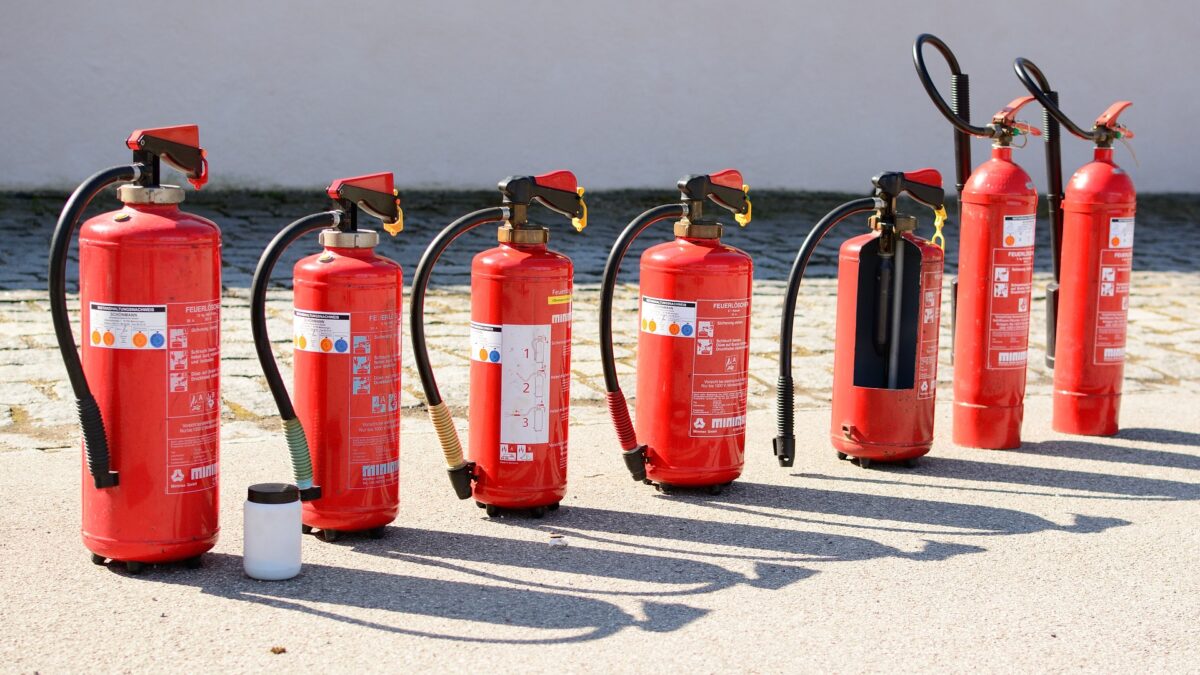
By neglecting occupational safety in case of noise, you risk hearing loss, insomnia and anxiety
19. July 2023.
Why is workspace temperature key to occupational safety and how to keep it optimal?
8. August 2023.Fire extinguishers are extremely important means of safety at work, which provide effective fire protection and save lives in the event of an outbreak of fire hazard.
In many laws and regulations, such as the Law on Safety at Work, the Ordinance on Fire Protection and the Ordinance on Fire Extinguishers, guidelines and obligations related to the use of fire extinguishers in the working environment are prescribed.
E.g. in the Occupational Safety Act, Article 18. prescribes the obligation of the employer to ensure adequate measures of protection against fire and other emergency situations and a sufficient amount of fire extinguishers. Also, Article 32. it prescribes an obligation on the employer to carry out a risk assessment, including the identification of the need for fire extinguishers and the planning of their location at the workplace.
The role of fire extinguishers in occupational safety
Fire extinguishers are associated with occupational safety because they provide employees with a means of rapid intervention in the event of a fire outbreak. Ensuring the right number of fire extinguishers, their proper location and regular maintenance are key factors in maintaining safety in the workplace.
The purchase of fire extinguishers can be done through specialized stores, occupational safety suppliers or through online stores. It is important to choose a reliable seller that offers certified fire extinguishers complying with applicable standards and regulations.
Selection of fire extinguishers
The selection of fire extinguishers is carried out according to the Ordinance on the maintenance and selection of fire extinguishers.
When choosing the type and quantity of fire extinguishers, we rely on the term ‘Unit fire extinguisher’ which refers to a portable or transport apparatus in which an extinguishing agent that is extinguished under pressure from the tank of the apparatus, or an apparatus by which we determine the required amount of fire extinguisher.
As they note on the vatrogastvo.hr, the required number, type and size of fire extinguishers is determined in accordance with the class of fire that may occur on the building and the calculation of the fire load of the building. Also, fire extinguishers must be installed in facilities even if they have a stable installation for extinguishing fires and a hydrant network installed.
| Unit appliances for areas up to 20 m2 are: | Unit appliances for areas greater than 20 m2 are: |
|
|
In high fire load facilities, for every 500 square meter to the number of appliances from Table 1 should be added one transport apparatus to powder 50kg, halon 25kg or air foam 50kg.
Companies and other legal entities that are obliged to adopt the “Fire Protection Plan” (classified in the I and II categories of fire threat), make the selection of fire extinguishers based on the risk assessment and this normative act.
For buildings classified in category III and IV fire hazards, the required amount of fire extinguishers is determined based on the size of the space to be protected and the fire load.
Fire extinguishers must be installed in conspicuous and easily accessible places, near a possible outbreak of fire (portable at a height of no more than 1.5 meters).
On the vatrogastvo.hr it is also noted that the extinguishing medium that is placed in the container of the apparatus is selected depending on the type of material or space being protected (fire classes A, B, C, D).
Types of extinguishing media are:
- powder (of different types for different classes of fire),
- halon (more recently various substitutes for halon due to its harmful properties),
- carbon dioxide – CO2,
- water
- foam
Number of required unit fire extinguishers with regard to the fire load and the area of the building according to Table 1. Regulations on the maintenance and selection of fire extinguishers.
Table 1
| Object area (m2) | Fire load | ||
| to | low (up to 1GJ/m2) | Medium (1 to 2GJ/m2) | high (above 2GJ/m2) |
| 50 | 2 | 2 | 2 |
| 100 | 2 | 2 | 3 |
| 150 | 2 | 3 | 3 |
| 200 | 3 | 3 | 4 |
| 300 | 3 | 3 | 5 |
| 400 | 3 | 4 | 6 |
| 500 | 3 | 4 | 7 |
| 750 | 4 | 6 | 9 |
| 1000 | 5 | 7 | 12 |
| 2000 | 6 | 9 | 17 |
| 3000 | 7 | 12 | 22 |
| 4000 | 10 | 17 | 32 |
| 5000 | 12 | 22 | 42 |
| 6000 | 15 | 27 | 52 |
| 7000 | 17 | 32 | 62 |
| 8000 | 20 | 37 | 72 |
| 9000 | 22 | 42 | 82 |
| 10.000 | 27 | 52 | 101 |
Regular maintenance of fire extinguishers is of utmost importance in order to be in working order for use.
For additional information on safety at work, specific requirements and the latest regulations, it is recommended to consult with experts in the field of safety at work


